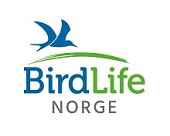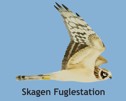
|
|
Birders Daily migration counts. The greylag geese have started moving, and the wader migration have started. A good start of autumn campaign 2013
By M. Wold Most willow warblers have been ringed so far, with the majority belonging to this year's young generation (87 individuals in total), followed by local house sparrows (58) and starlings (38). Most of the birds ringed in the autumn are young birds, and part of the job the ringers do is to determine how far every bird has come in the process of changing from juvenile to post-juvenile body feathers. This is a measure (for most birds) of how old it is, i.e. how long since it fledged. We use this as an indication of whether the bird is local, since the youngest birds will not have managed to fly very far yet. The picture on the right-hand side shows a young starling. The starling's juvenile plumage is light brown, while the post-juvenile plumage consists of the characteristic black feathers with white tips. The bird in the picture has started the moulting process, and the first set of black feathers can be seen growing on the flanks. As the autumn progresses, more and more of the black post-juvenile feathers will replace the brown juvenile ones. In comparison with the last 10-15 years, we have ringed an unusual high number of whinchats, in total 15 individuals. By 23rd of July in previous years the number has been typically 2-5 after the first week of the campaign. Looking at the ringing numbers from the marsh, this autumn might have produced a good number of whinchats. Whinchat is one of the species with a significant, negative long-term trend in the standardized ringing campaigns at Lista, and the same trend is seen at Jomfruland Bird Observatory. It is possible that the whinchat has succeeded especially good this year, or that the young ones are early this year compared to previous years. It remains to be seen what the total number will end up at, and we follow this species as the autumn progresses. During these pleasant, warm summer days the lighthouse area is filled with activity. Many birders are around to observe the first migrating waders, and the first flocks of grelag geese on their way south. This year we also have nine house martin nests around the lighthouse, and the air is buzzing with young swallows honing their flying skills. This autumn we have a new ringer from Catalonia with us, Albert Burgas from Montgri. Together with Aïda Lopez he will be doing the ringing campaign and bird census this season. Nature and bird guide Thomas Bentsen is also on the hill every morning, to arrange ringing demonstrations for visitors, and to talk bird and nature with everyone interested visiting the lighthouse area. | ||||||||

| Ringing numbers | ||||||||||
|
| Reportasje fra Lista FS i Aftenposten |

|
| Seasonal deviation | ||||||||||||||||||||||||||||||
|
|
Følg Følg Lista FS på facebook.com |
| Siste 5 på siden |
|
Begynnerkurs i ringmerking: 17.-18. august The annual report for 2023 is available! Fuglefestival 2.-3. september Report from spring 2023 Ny rapport: Måling av elektromagnetiske feltstyrke fra fugleradar ved Lista fyr. |
| Nyheter fra NOF |
|
Ankerfjella IBA trues av... Kraftlinjer og vindmøller... Lille måltrost og den enda... Fine hekkeflåter til ternene... Statsforvalteren sier nei til... Hotell i særklasse Tusenvis av svarttrost: Hvor... Kulturlandskapsarten... |
Lista Fuglestasjon
Fyrveien 6
NO-4563 Borhaug
post@listafuglestasjon.no Tlf: 949 86 793
 |  |


 Only in English
Only in English



